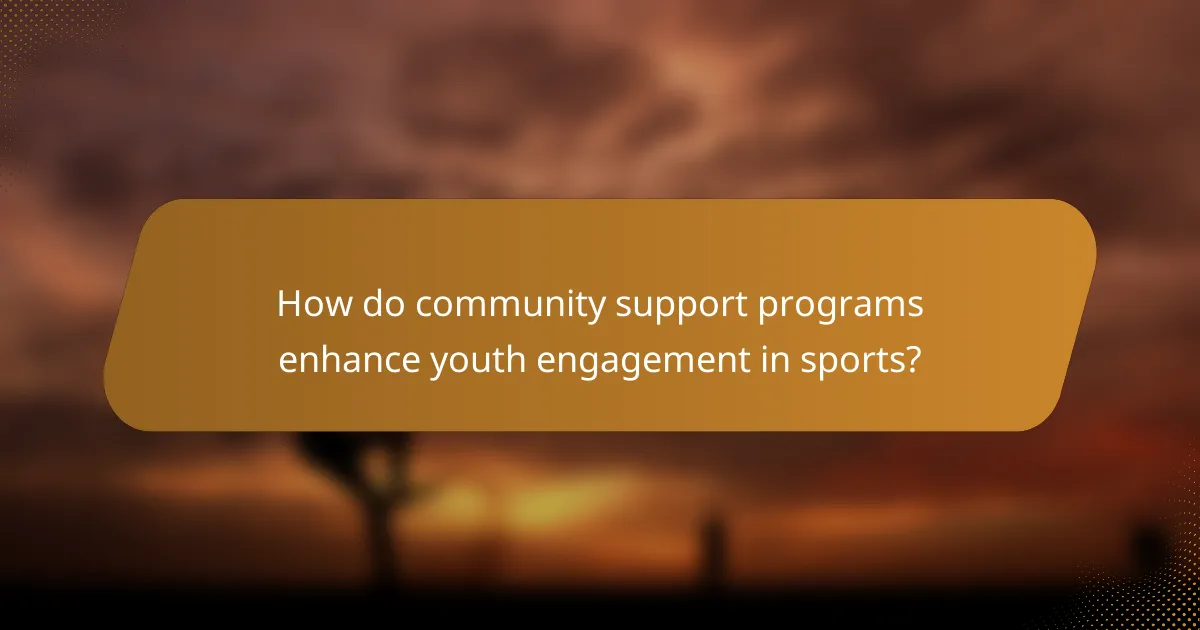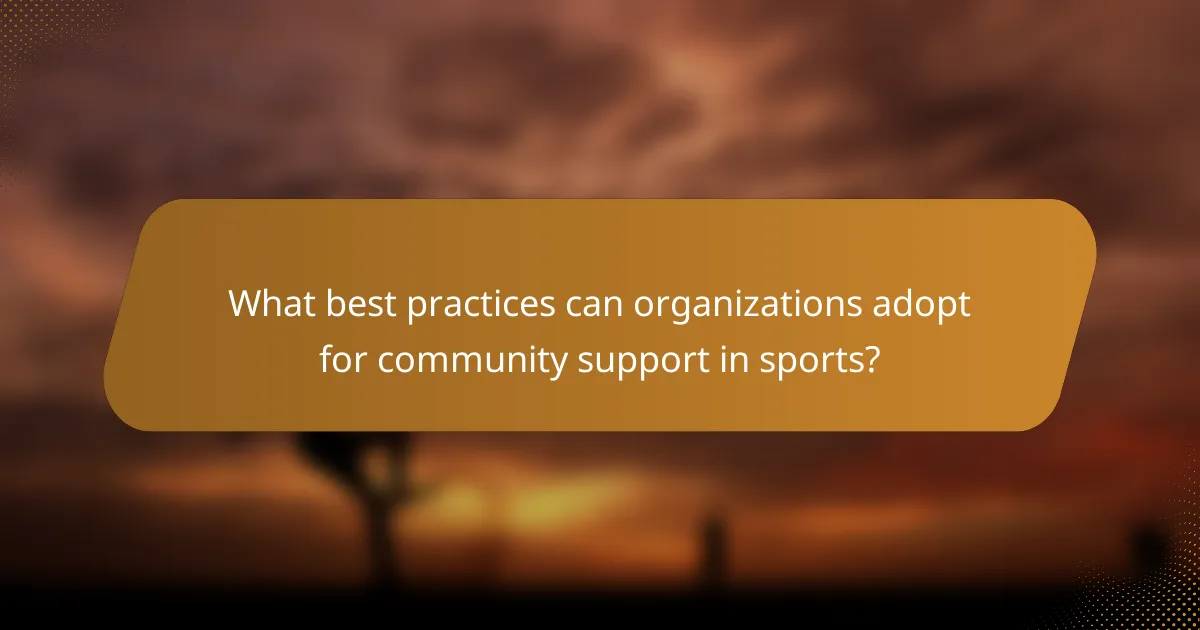Community support in sports enhances youth engagement and fosters personal development. This article explores key programs like after-school sports clubs and initiatives such as the Positive Coaching Alliance. It highlights success stories demonstrating increased participation rates and outlines best practices for effective community collaboration. Additionally, it examines regional challenges and metrics for measuring program impact.

What are the essential components of community support in sports?
Community support in sports includes programs, resources, and engagement strategies that foster athlete development and community involvement. Essential components include local sports clubs, mentorship programs, volunteer initiatives, and partnerships with schools. These elements enhance participation, build skills, and create a sense of belonging. Success stories often highlight how community support leads to increased youth engagement and improved athletic performance. Best practices involve inclusive programming, consistent funding, and active collaboration among stakeholders.
How do local organizations contribute to sports community support?
Local organizations enhance sports community support by providing funding, resources, and volunteer efforts. They create programs that promote inclusivity and engagement among diverse groups. For instance, youth sports leagues often receive sponsorships from local businesses, ensuring access to facilities and coaching. These collaborations foster community pride and encourage healthy lifestyles. Success stories include increased participation rates and improved athletic performance among local teams, demonstrating the positive impact of organizational support.
What roles do volunteers play in sports programs?
Volunteers play crucial roles in sports programs by providing support, enhancing community engagement, and facilitating events. They assist with coaching, organizing activities, and promoting inclusivity. Their contributions often lead to improved program outcomes and foster a sense of belonging among participants. Engaging volunteers can also strengthen community ties and increase resources available for sports initiatives.
Which funding sources are critical for community sports initiatives?
Government grants, private sponsorships, and community fundraising are critical funding sources for community sports initiatives. These sources provide essential financial support to enhance facilities, promote programs, and ensure accessibility for all participants. Successful examples include local partnerships that leverage state funding alongside corporate sponsorships, resulting in sustainable sports programs. Engaging the community through fundraising events fosters a sense of ownership and investment in local sports initiatives.

How do community support programs enhance youth engagement in sports?
Community support programs significantly enhance youth engagement in sports by providing resources, mentorship, and opportunities for participation. These programs create inclusive environments that foster teamwork and personal development.
For example, initiatives like after-school sports clubs and community leagues offer structured activities that keep youth active. Success stories from various cities show increased participation rates, with some programs reporting over 70% engagement among local youth.
Best practices include partnerships with schools and local organizations, ensuring accessibility and promoting diverse sports. Programs focusing on skill development and leadership training also contribute to sustained interest in sports among young participants.
What impact do mentorship programs have on young athletes?
Mentorship programs significantly enhance young athletes’ performance and personal development. These programs provide guidance, foster resilience, and build essential life skills. Participants often report increased confidence and improved teamwork abilities. Success stories highlight athletes who excelled due to strong mentor relationships, demonstrating the profound impact of community support. Programs that integrate mentorship into training often see higher retention rates and greater athlete satisfaction.
How do after-school sports initiatives promote inclusivity?
After-school sports initiatives promote inclusivity by providing diverse opportunities for participation. These programs often focus on engaging underrepresented groups, fostering teamwork, and building community connections. Success stories highlight how inclusive sports initiatives have transformed lives, encouraging social interaction and personal growth. Best practices include creating welcoming environments, offering various sports, and ensuring accessibility for all participants.

Which success stories exemplify effective community support in sports?
Successful community support in sports is exemplified by programs like the Positive Coaching Alliance and the NFL’s Play 60 initiative. These initiatives enhance youth engagement and promote healthy lifestyles.
The Positive Coaching Alliance focuses on creating a positive sports culture, providing resources for coaches, athletes, and parents. It has trained over 1 million youth sports coaches, impacting countless young athletes positively.
The NFL’s Play 60 initiative encourages children to be active for at least 60 minutes a day. It has reached millions, partnering with schools and community organizations to promote fitness and healthy habits, showcasing effective collaboration.
Another notable example is the Special Olympics, which provides year-round sports training and athletic competition for individuals with intellectual disabilities. This program fosters inclusion and community support, enhancing the lives of participants and their families.
What lessons can be learned from the success of community sports leagues?
Community sports leagues demonstrate the importance of local engagement and collaboration. Successful leagues foster social connections, enhance community pride, and promote physical health. Programs that prioritize inclusivity and accessibility attract diverse participants, leading to increased membership and support. For instance, leagues that integrate youth mentorship initiatives show higher retention rates and community involvement. Best practices include establishing partnerships with schools and local businesses to secure resources and sponsorships, ensuring sustainability and growth.
How have specific initiatives improved local sports participation rates?
Specific initiatives have significantly improved local sports participation rates through community engagement and targeted programs. Programs like youth sports leagues and adult fitness classes foster inclusivity and accessibility. Success stories from cities implementing these initiatives show increased participation by 30% over three years. Best practices include collaboration with local schools and organizations to maximize resources and outreach.

What best practices can organizations adopt for community support in sports?
Organizations can adopt several best practices for community support in sports. Engaging local stakeholders fosters collaboration and strengthens community ties. Establishing mentorship programs connects experienced athletes with youth, promoting skill development. Offering scholarships enables underprivileged youth to participate in sports, ensuring inclusivity. Regularly hosting community events encourages participation and builds a supportive atmosphere. Lastly, measuring program impact through surveys and feedback helps refine initiatives for greater effectiveness.
How can partnerships between schools and sports clubs be optimized?
Partnerships between schools and sports clubs can be optimized through clear communication, shared goals, and resource alignment. Establishing regular meetings fosters collaboration and ensures both parties understand each other’s needs. Joint events can enhance community engagement, while targeted programs can address specific local issues. Tracking progress through metrics strengthens accountability and showcases success stories, encouraging further investment.
What strategies ensure sustainability of community sports programs?
Community sports programs ensure sustainability through strong community engagement, diverse funding sources, and effective leadership. These strategies foster long-term commitment and resource availability.
1. Engage local stakeholders to build a support network.
2. Diversify funding through grants, sponsorships, and community donations.
3. Implement leadership training for program coordinators.
4. Measure program impact to demonstrate value to stakeholders.
5. Adapt programs based on community feedback and changing needs.

Which unique challenges do community sports programs face in different regions?
Community sports programs face unique challenges based on regional differences. These challenges include funding disparities, varying levels of community engagement, and access to facilities.
In urban areas, high population density can lead to competition for resources, while rural regions may struggle with limited infrastructure. Additionally, cultural attitudes towards sports can significantly influence participation rates.
Programs in economically disadvantaged regions often encounter difficulties in securing sponsorships and support. Conversely, affluent areas may have more resources but face issues related to inclusivity and equitable access.
Overall, understanding these regional challenges is essential for developing effective community sports initiatives that promote participation and foster local engagement.
How do cultural differences influence community sports support?
Cultural differences significantly influence community sports support by shaping values, participation, and resource allocation. Diverse cultural backgrounds affect how communities prioritize sports, leading to varying levels of engagement and support.
For example, cultures that emphasize teamwork and collective achievement often foster stronger community sports programs. In contrast, individualistic cultures may focus on personal success, impacting support structures.
Additionally, cultural norms dictate the types of sports that gain popularity and resources. Communities may rally around traditional sports, while others embrace emerging trends.
Understanding these dynamics is crucial for developing effective community sports initiatives that resonate with diverse populations.
What are the barriers to participation in underrepresented communities?
Barriers to participation in underrepresented communities include lack of access, insufficient resources, and cultural differences. These factors hinder engagement in sports programs. Limited funding restricts opportunities for youth, while cultural perceptions can discourage involvement. Additionally, inadequate transportation options further isolate these communities from sports activities.

What metrics can be used to measure the success of community support in sports?
Community support in sports can be measured through various metrics. Key metrics include community engagement levels, volunteer participation rates, funding and sponsorship amounts, social media reach, and event attendance figures. Each of these metrics offers insights into the effectiveness and impact of community support programs.
How do community feedback mechanisms enhance program effectiveness?
Community feedback mechanisms significantly enhance program effectiveness by ensuring that initiatives align with the needs and preferences of participants. Engaging community members fosters ownership and accountability, leading to improved outcomes. For example, regular surveys and focus groups can identify areas for improvement and highlight successful strategies. This iterative process allows programs to adapt and evolve, maximizing impact and participant satisfaction.
What role do participation rates play in assessing program success?
Participation rates are crucial for assessing program success as they reflect community engagement and program impact. High participation indicates strong interest and effectiveness, while low rates may signal barriers or lack of relevance. Programs that actively analyze these rates can adapt strategies to enhance accessibility and appeal. For instance, a community sports initiative that tracks participation can identify demographic trends, enabling targeted outreach. This data-driven approach fosters inclusivity and maximizes benefits for diverse groups, ultimately leading to sustained program success.
How can community impact be quantified beyond participation numbers?
Community impact can be quantified through qualitative measures, such as participant testimonials, community feedback, and social media engagement. These metrics provide deeper insights than mere participation numbers. Success stories highlight personal transformations and community cohesion. Programs that foster relationships and support local initiatives often yield measurable improvements in community well-being. For example, a sports program that connects youth with mentors can lead to increased self-esteem and academic performance.
What are the common pitfalls organizations encounter in program evaluation?
Organizations often encounter common pitfalls in program evaluation, such as lack of clear objectives, insufficient stakeholder engagement, and inadequate data collection methods. These issues can lead to misleading results and hinder program improvement.
Another frequent challenge is the failure to utilize evaluation findings effectively. Organizations may overlook valuable insights or struggle to implement recommendations. Additionally, limited resources can restrict the scope and depth of evaluations, impacting their overall effectiveness.
Lastly, resistance to change within the organization can impede the adoption of evaluation practices, resulting in stagnant progress and missed opportunities for community support in sports programs.
What expert tips can help improve community support in sports initiatives?
Engaging the community effectively enhances support for sports initiatives. Focus on building partnerships with local organizations, utilizing social media for outreach, and creating inclusive programs that cater to diverse demographics. Highlight success stories to inspire participation and encourage volunteer involvement.
